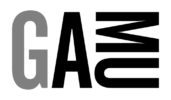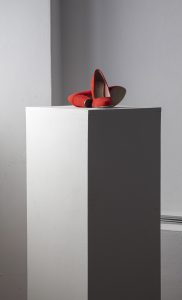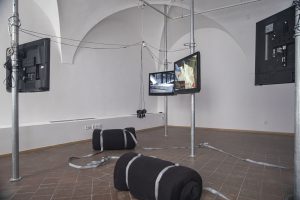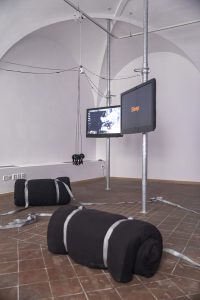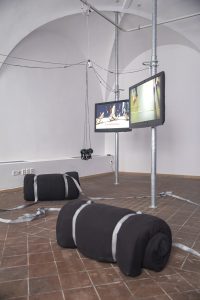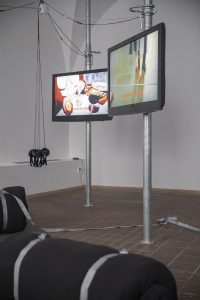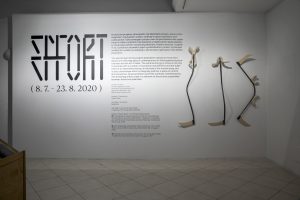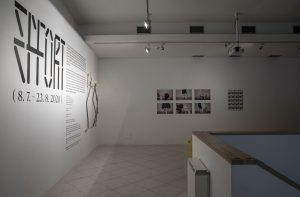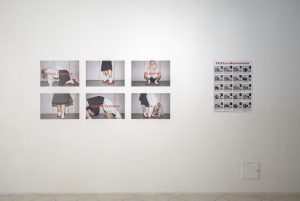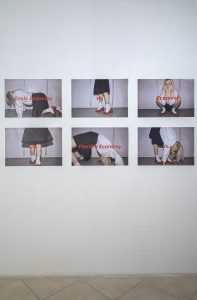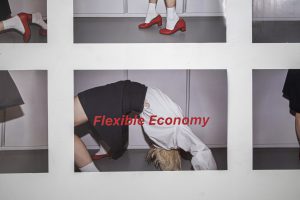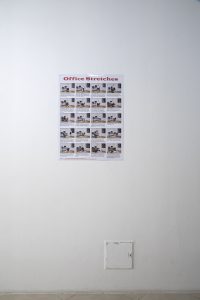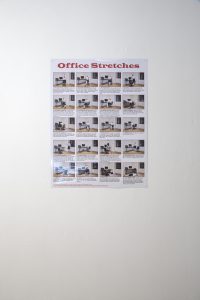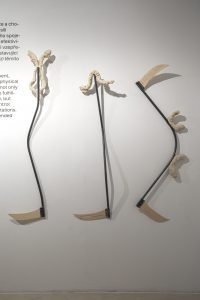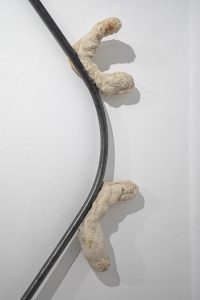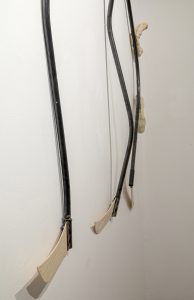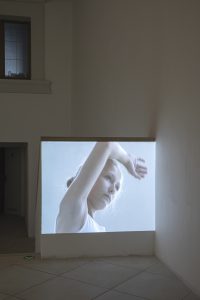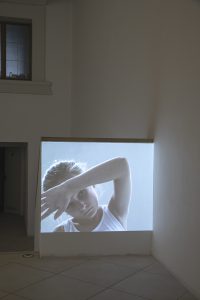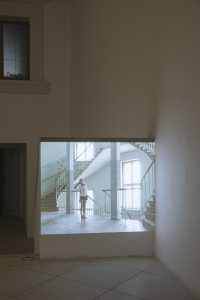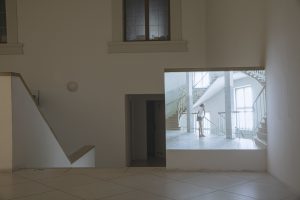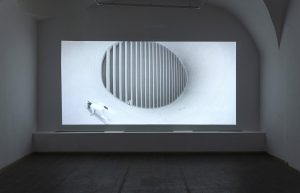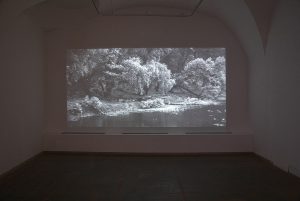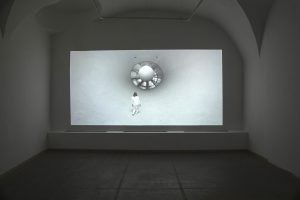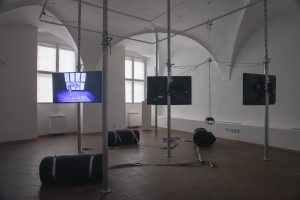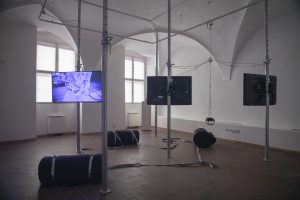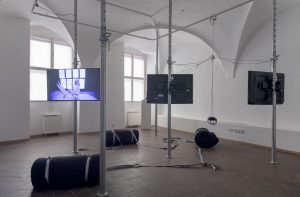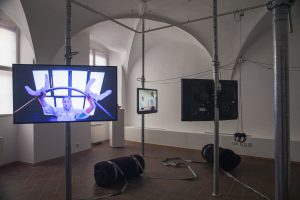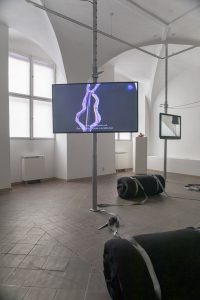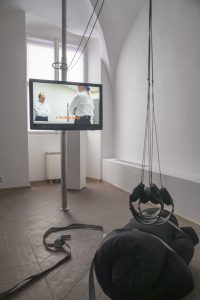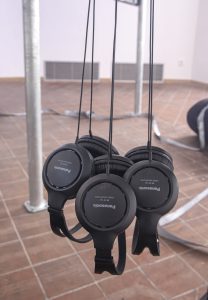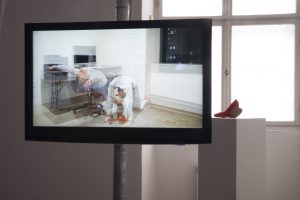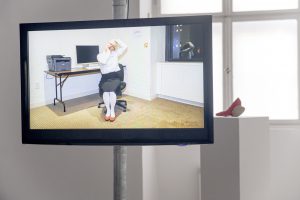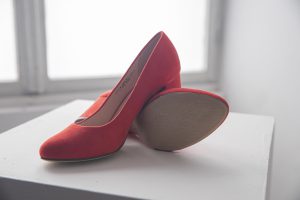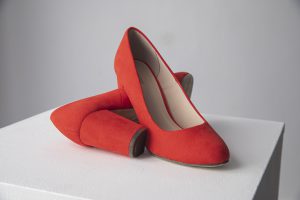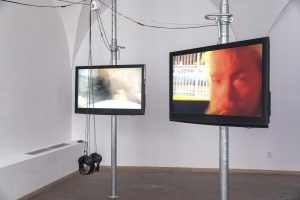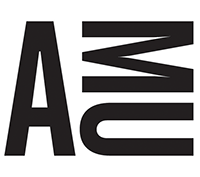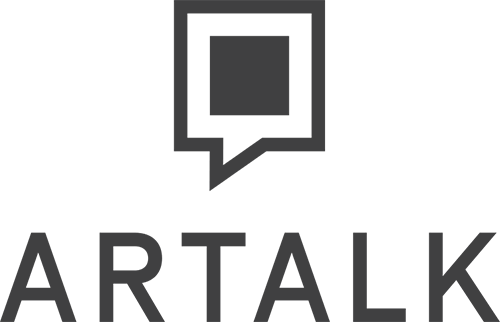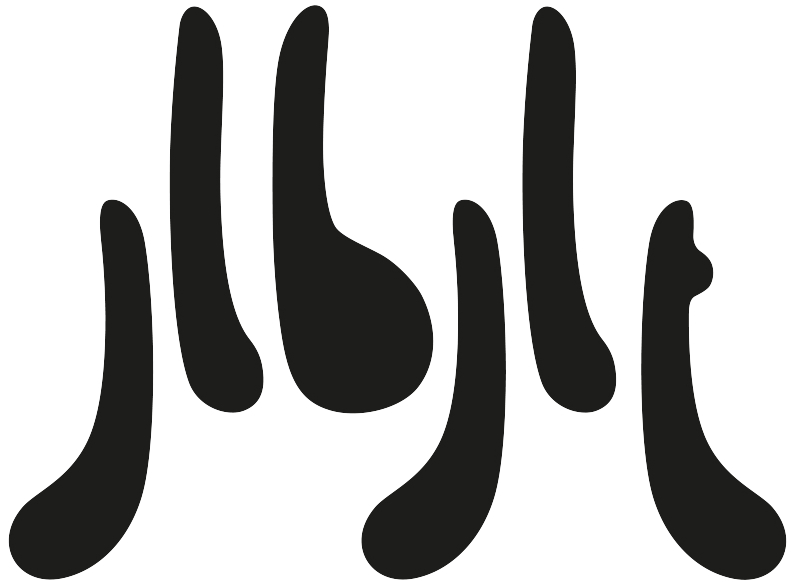8. 7. – 23. 8. 2020 (opening: Tuesday 7th of July 2020, 6:00 PM)
Phoebe Berglund (USA), Veronika Čechmánková (CZ), Agnieszka Mastalerz (PL) a Michał Szaranowicz (PL)
curated by: Viktor Čech
exhibition architecture: Matěj Kos
graphic design: Jan Slabihoudek
Accompanying program:
- Analysis of Choreography and Movement (workshop by Hana Polanská Turečková): 21st of July, 4 PM
- Lecture effort (lecture by Viktor Čech): 5th of August, 6 PM
- Guided tour (by Viktor Čech): 20th of August, 6 PM
The second part of the project dedicated to physical movement, dance and choreography in contemporary art interrogates physical exertion and the act of labor. The will and energy to move is not only connected with a number of functional mechanisms and the fulfillment of an ideal effectiveness in the field of the human body, but is also a landscape which is integrally political, a place of control and resistance, physical effects and their symbolic manifestations. The exhibiting artists meet in a network of structures suspended between these two polarities.
The physical exertions with which we perform any motion have many various aspects and qualities which influence not only their function and results, but also their visual form. As the modernist choreographer Rudolf Laban already showed in his research of motion as a site of work, the connection between a specific quality of our physical exertion, whether we mean the strength we put in, its speed or flow, leads directly to defining certain choreographic forms. The topic of exertion however cannot be discussed only from the vantage point of the human body’s biomechanics. It is closely connected with our will to actively inhabit this world and we cannot imagine performing any activities, much less work, without it.
Any physical exertion is closely connected to the processes of labor/work, their direction, motivation and reflexive relationship to our body. Just like with the focus on choreography, we cannot avoid the question of control, appropriation and objectification of the human body. Many research projects indeed closely studied these circumstances – and not just in the extreme efficiency of Fordism – which led to the incessant repetition of a limited register of movements on the part of the worker and also included visual analyses of motions of labor. The seeming boundary between the world of industrial production and the aesthetics of movement was collapsed in the work of Soviet avant-garde researcher and poet Alexei Gastev, the head of the Moscow Labor Office. His poetry celebrates the synthesis of the worker and the machine, and the visual analyses of work activities constitute a beautiful example of this.
At least since 19th century modernism, labor, its political, social and ethical value has also constituted an important topic for visual art. This exhibition project would like to approach this topic from a specific perspective which melds a choreographic understanding of movement as a form and function with the viewpoint of visual art which examines these aspects in their symbolic and formal representation. The presented work of American choreographer and artist Phoebe Berglund, the Czech artist Veronika Čechmánková and the Polish artists Agnieszka Mastalerz and Michal Szaranowicz focuses on various aspects of the above-mentioned: on the relationship between a physical effort at movement, the social and cultural contexts connected with it and the understanding of the role of our embodiment within this complex webbing.
Phoebe Berglund: Basic Economy vs. Economy vs. Flexible Economy
three channell video, 2020, 15 mins
Basic Economy vs. Economy vs. Flexible Economy is a three-channel employee training video that explores the relationship between the flexible body of the worker and flexible economic models. Berglund plays the role of the Sotheby’s office worker, moving through tasks in her office on Wall Street to sleepless nights in a hotel room during a business trip to Shanghai, to her apt in Soho during Covid-19 quarantine. We watch her work, eat, sleep, take taxi rides on highways and dance at night. The videos are narrated by Berglund, who weaves text from human resources websites with fiction and her personal travel diary. Themes that run throughout are social and economic mobility, itinerant lifestyle, aspirational wealth, solitude, cybersex, time and debt.
Phoebe Berglund: Work Poster: Office Stretches
three posters, 2020
Cubicle by Phoebe Berglund invites us to imagine a darkened, vacant office in Manhattan. Staff are no longer present, working from home while in quarantine. A laminated chart entitled “Office Stretches” hangs in solitude in an empty cubicle, presenting a range of effective stretching exercises for office workers. These images of the body wait for the workers to return and assume their positions.
Imagine you are the worker. Place one hand softly on the top of your head and cradle your chin with the other. Tilt your neck to the left, guiding it with your hands, until you feel a stretch. Place both hands on the small of your back in the shape of a diamond. Take a deep breath in and look up to the ceiling. Rest your forehead on your keyboard and listen to your heartbeat. Spread your legs, make a phone call. Imagine yourself in another realm. Press your face to the Microsoft Office Window screen and you will see me. I am in your cubicle, you are in your body, we are moving together as one, now, in virtual time and space, dancing till the world ends.
Work Poster: Office Stretches was commissioned by Wendy’s Subway and designed by Simran Ankolkar. The printed poster is available to order from Wendy’s Subway at https://bit.ly/workposters
Veronika Čechmánková: Dialog with The Previous
video, 2019, 2:15 mins, installation
In her video performance, Veronika Čechmánková connects two seemingly contrasting worlds. The first is the contemporary culture of the exercising body, nowadays oftentimes connected to trends such a yoga and the search for a mythical integrity and balance between soul and body. The second is the world of our rural great-grandmothers, with their every-day hard work and the all-too literal earning of their daily bread. The ritual of harvest, of working with a scythe, its choreography, is portrayed here as a form of initiation – through the individual exertions towards the final catharsis which takes the form of bread. In some ways, the ideal world of hard work and bread-winning of former village life, connected with the endless repetition of the cycles of human life and nature, melds with contemporary civil reality in which a similar exertion and disciplining of the body in gyms seems more like a simulacrum which covers over the technocratic aspects of our society.
Agnieszka Mastalerz & Michał Szaranowicz:
Primary Swarm, 2020 and Sluice, 2018, loop
In Warsaw, on the East bank of the Vistula, across the river from the Museum of Modern Art an investment Port Praski (in English: Prague Harbour) is being realised. Between 1885-2012 the area served as a harbour, which was surrounded by rather poor tenement buildings and a green wasteland, there was a slaughterhouse, too. The ambitious emerging housing development should change the place’s aura for a European-class district. The investment cannot be finished until a water lock is built.
The installation touches upon Port Praski and points out to the sluice’s function – as a mechanism that changes level of something that goes through it.
The installation comprises two videos by Agnieszka Mastalerz and Michał Szaranowicz: Sluice (the anthropometric gate out of hands, 2018) and Primary Swarm (the group of explorers which traverses a cocoon-like space, as well as the black-and-white registration of an unaffected part of today’s Port Praski, 2020).
video by Miroslava Konečná
Hana Polanská Turečková: Choreography and Analysis of Movement (workshop)
In the first half of the 20th century, Rudolf Laban developed an analysis of movement which even today remains unrivalled. There, he also studied workers during labor. He then managed to accurately describe and categorize their every-day gestures and functional movements and integrate them into a systematic study. His analysis of the complex understanding of movement includes the body, effort, shape and space harmony. During our workshop, we will attempt to use the study of effort so that we might see how to perform movement in our everyday lives and how we might be able to expand it into the field of dance expression. Together, as a group, we will then create a choreography inspired by Rudolf Laban’s analysis and we will use this time to have fun and study the question of movement in relation to its quality.
Lecture effort (lecture by Viktor Čech)
photo by Světlana Malinová
